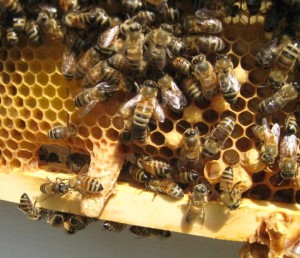Why I Never Requeen
A fellow beekeeper, who had just caught a swarm, texted me a day or two ago to understand why I do not requeen. Since it is on my mind this morning, I thought I would dig a little deeper into the topic and at least provide the logic behind “why I do what I do”:)
First, why do people requeen? I do not do it, so this is all heresay – I have heard lots of people talk about it (including the State Apiarist in Virginia).
As a Matter of Course
Most people talk about requeening an established hive. The logic seems to be that getting a new, young queen into the hive every Fall (or maybe every other Fall) reduces the chances of an old drone laying queen, disease or swarming.
In a Swarm
But, in the case above, the beekeeper had heard folks say you really want to requeen a swarm. I believe that some folks like to requeen swarms because they like to have a queen with genetics that they know leading their hives (who knows what this swarm queen might be made of!) I also once heard our state apiarist make the case that you really do not want a queen with an inclination to swarm – and many queens in a swarm are just that.
Try Something New
The third reason is to get a new strain of bee. Maybe you want a Russian line or some other new line of honey bee – the easiest way to get that is to buy a queen from that new line and install her into your hive. Of all of the reasons, this one is the only one that makes sense to me. I no longer do it, but who knows if I may want to experiment in the future? Trying out a new line of bees seems like good fun – it may be the end of the colony, but it’s fun to see what happens.
We Got Problems, Charlie!
The final reasons is when you have a problem – like a drone layer, a nasty, mean hive or maybe a queen that simply is not building up. These are all good reasons, in my book, to requeen. In most cases, I simply find the errant queen, squash her and come back in 3 to 4 weeks to make sure they raised a new gal. With a drone layer, I combine it with a Nuc (I always have one on hand, every day of the year.)
So, why don’t I requeen (excepted as noted above)?
The Ole Gal Is Proven!
I grew up on a farm. When you have a proven line, you do everything you can to continue that line. It makes absolutely no sense to me to look at an established hive, remark how great a line of bees you have there, and then kill the queen and replace her with an unknown factor (some foreign bee). In 99% of the cases, I let my bees replace their queen in their own time. Although the majority of my queens were born last year, I have quite a few that were born 2 and 3 years ago.
Why Not Requeen a Swarm?
I manage my bees based on Darwinism. I do not medicate or really baby them – if they cannot make it in my environment, I bid them farewell. The colonies that do really well are the ones that I create lots of Nucs and splits from. This methodology has really worked for me – I never have anywhere near the losses that the state reports in a give Winter.
When I get a swarm of bees, I know very well there is chance that these are inferior bees. But, there is also a chance that this is from a feral swarm that has been living out in the wild for a few years. I WANT these genes!! Instead of requeening, I actually track my swarms and attempt to spread those genes (through increase) to several of my apiaries over the next couple of years. So, I not only do not requeen a swarm, but I actively am looking for queens in swarms!!
What Is Requeening to Me (when I do it)?
When I do requeen, it is never with a foreign bee. If it is early enough in the year, I just cull the old queen and let my gals raise their own queen. I keep the blood line, break the mite cycle and let nature takes its course. If I just requeened this bunch (maybe Mama was mean as a snake) and am discovering that little princess is equally as mean, I sometimes provide eggs from another nearby hive (aka proven line of bees.)
In the case of a drone layer, I always combine them with a Nuc. It’s a completely different topic (that I sometimes go on and on about), but every beekeeper should always have a Nuc sitting nearby, ready to solve a problem.
The bottom line is that requeening is not part of my general beekeeping tasks and goes against my philosophy, in most cases. I am sure that others have had great success with it. For me, it doesn’t make sense.

